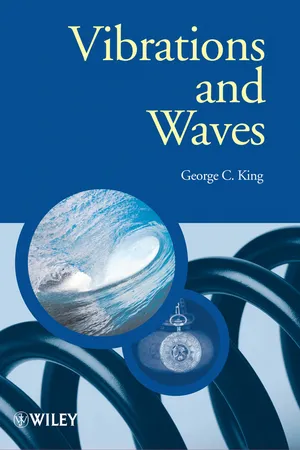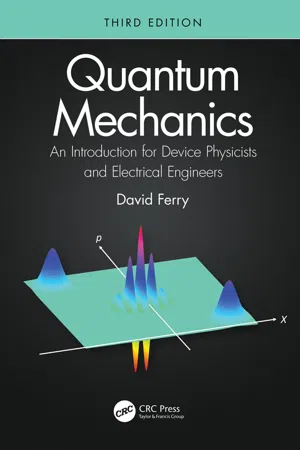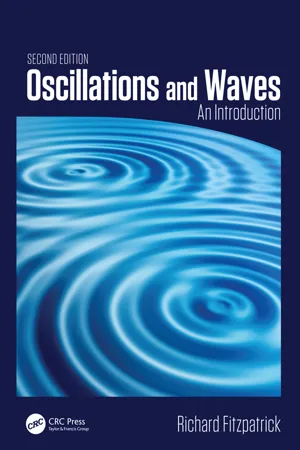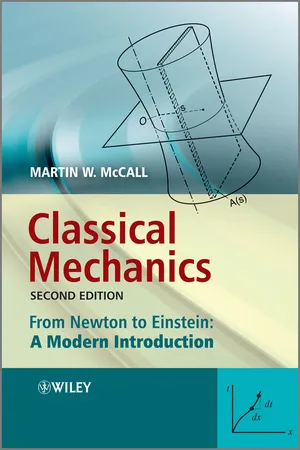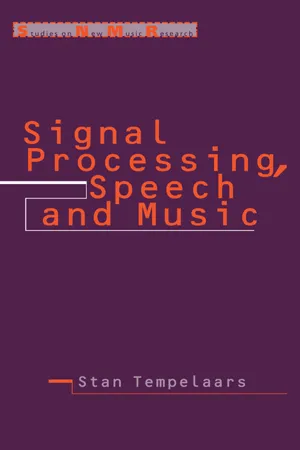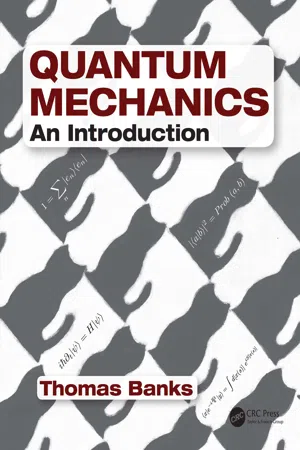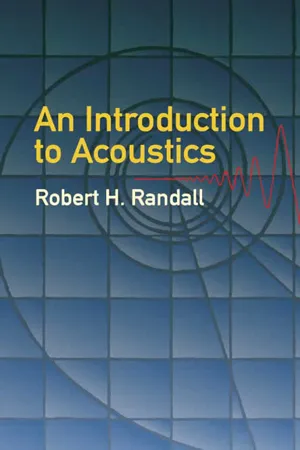Physics
Simple Harmonic Oscillator
A simple harmonic oscillator is a system that exhibits a specific type of periodic motion, where the restoring force is directly proportional to the displacement from equilibrium. This results in a sinusoidal motion characterized by a constant frequency and amplitude. Examples of simple harmonic oscillators include a mass on a spring and a pendulum.
Written by Perlego with AI-assistance
Related key terms
Related key terms
1 of 4
Related key terms
1 of 3
12 Key excerpts on "Simple Harmonic Oscillator"
- eBook - ePub
- A. L. Stanford, J. M. Tanner(Authors)
- 2014(Publication Date)
- Academic Press(Publisher)
Idealized systems that execute simple harmonic motion are the primary considerations of this chapter. A discussion of quantities that characterize simple harmonic motion will be followed by a detailed kinematic analysis of that kind of motion. Then we will consider the dynamics of ideal oscillators, relating the forces that cause simple harmonic motion to the motion itself. Energy considerations will complete our analysis of idealized oscillators.Having described idealized simple harmonic motion in terms of kinematics, dynamics, and energetics, we will turn our attention to more realistic mechanical oscillators. Damped oscillations, back and forth motions with decreasing energies, will be given a brief treatment. Finally, oscillators that are driven, or forced, by an external mechanism will be discussed qualitatively. These forced oscillations demonstrate resonance, an important physical phenomenon observed in many kinds of systems.8.1 Simple Harmonic Motion
Our description of simple harmonic motion will necessarily be essentially mathematical. You may wish to create a mental image of the kind of motion we are describing by imagining a long spring hanging from a ceiling with a block attached to the lower end of the spring. When the block has been pulled downward and released, it oscillates, vertically in this case. First we will describe an idealization, that is, a frictionless version, of this kind of motion.Let us consider the rectilinear (straight-line) motion of a particle with displacement from x = 0 that is described byx(8-1)( t )= A cos(ω t + ϕ)(8-1)where A , ω, and ϕ are constants. Motion of this type is said to be “harmonic” because it can be described by sinusoidal (sine or cosine) functions. The motion is said to be “simple” in that only one sine or cosine function is required to describe it. Equation (8-1) , therefore, describes the displacement from x = 0 of a particle executing simple harmonic motion . The argument (ωt + ϕ) of the cosine factor in Equation (8-1) is called the phase of the oscillation, and ϕ is called the phase constant . Since A is a constant, the displacement x of the particle is periodic because cosine is a periodic function that repeats itself each time the phase increases by 2π radians. Furthermore, x ranges from x = A , when the cosine factor is equal to 1, to x = −A , when the cosine factor is equal to −1, and back again to x = A , and so on, as time proceeds from t - eBook - ePub
- George C. King(Author)
- 2013(Publication Date)
- Wiley(Publisher)
1
Simple Harmonic Motion
In the physical world there are many examples of things that vibrate or oscillate, i.e. perform periodic motion. Everyday examples are a swinging pendulum, a plucked guitar string and a car bouncing up and down on its springs. The most basic form of periodic motion is called simple harmonic motion (SHM). In this chapter we develop quantitative descriptions of SHM. We obtain equations for the ways in which the displacement, velocity and acceleration of a Simple Harmonic Oscillator vary with time and the ways in which the kinetic and potential energies of the oscillator vary. To do this we discuss two particularly important examples of SHM: a mass oscillating at the end of a spring and a swinging pendulum. We then extend our discussion to electrical circuits and show that the equations that describe the movement of charge in an oscillating electrical circuit are identical in form to those that describe, for example, the motion of a mass on the end of a spring. Thus if we understand one type of harmonic oscillator then we can readily understand and analyse many other types. The universal importance of SHM is that to a good approximation many real oscillating systems behave like Simple Harmonic Oscillators when they undergo oscillations of small amplitude. Consequently, the elegant mathematical description of the Simple Harmonic Oscillator that we will develop can be applied to a wide range of physical systems.1.1 PHYSICAL CHARACTERISTICS OF Simple Harmonic OscillatorS
Observing the motion of a pendulum can tell us a great deal about the general characteristics of SHM. We could make such a pendulum by suspending an apple from the end of a length of string. When we draw the apple away from its equilibrium position and release it we see that the apple swings back towards the equilibrium position. It starts off from rest but steadily picks up speed. We notice that it overshoots the equilibrium position and does not stop until it reaches the other extreme of its motion. It then swings back toward the equilibrium position and eventually arrives back at its initial position. This pattern then repeats with the apple swinging backwards and forwards periodically . Gravity is the restoring force that attracts the apple back to its equilibrium position. It is the inertia - eBook - ePub
Quantum Mechanics
An Introduction for Device Physicists and Electrical Engineers
- David Ferry(Author)
- 2020(Publication Date)
- CRC Press(Publisher)
5The Harmonic Oscillator
One of the most commonly used quantum mechanical systems is that of the simple harmonic oscillator . The prototype system is the simple pendulum. Classically, the motion of the system exhibits harmonic, or sinusoidal oscillations. Quantum mechanically, the motion described by the Schrödinger equation is more complex. Although quite a simple system in principle, the harmonic oscillator assumes almost overwhelming importance due to the fact that it is one of the few systems that can be solved exactly in quantum mechanics. Almost any interaction potential may be expanded in a Tayor series with the low-order terms (up to quadratic order) cast into a form described by the harmonic oscillator. The sinusoidal motion of classical mechanics is the simplest system that produces oscillatory behavior, and therefore is found in almost an infinity of physical systems. Thus, the properties of the harmonic oscillator become important for their use in describing quite diverse physical systems. In this chapter, we will develop the general mathematical solution for the wave functions of the harmonic oscillator, using a simple operator algebra that allows us to obtain these wave functions and properties in a much more usable and simple manner. Classically, the harmonic oscillator is described in terms of Hermite polynomials, as the differential equation is one of the variants of the Sturm-Liouville problem. We can obtain these functions without the normal complication of solving the detailed differential equation, as the operator approach makes life easier. We then turn to two classic examples of systems in which we use the results for the harmonic oscillator to explain the properties: the simple LC - eBook - ePub
Oscillations and Waves
An Introduction, Second Edition
- Richard Fitzpatrick(Author)
- 2018(Publication Date)
- CRC Press(Publisher)
CHAPTER 1Simple Harmonic Oscillation
1.1 INTRODUCTIONThe aim of this chapter is to investigate a particularly straightforward type of motion known as simple harmonic oscillation, and also to introduce the differential equation that governs such motion, which is known as the Simple Harmonic Oscillator equation. We shall discover that simple harmonic oscillation always involves a back and forth flow of energy between two different energy types, with the total energy remaining constant in time. We shall also learn that the linear nature of the Simple Harmonic Oscillator equation greatly facilitates its solution. In this chapter, examples are drawn from simple mechanical and electrical systems.1.2 MASS ON SPRINGConsider a compact mass m that slides over a frictionless horizontal surface. Suppose that the mass is attached to one end of a light horizontal spring whose other end is anchored in an immovable wall. See Figure 1.1 . At time t, let x(t) be the extension of the spring; that is, the difference between the spring’s actual length and its unstretched length. x(t) can also be used as a coordinate to determine the instantaneous horizontal displacement of the mass.The equilibrium state of the system corresponds to the situation in which the mass is at rest, and the spring is unextended (i.e., x = ẋ = 0, where ̇. ≡ d/dt). In this state, zero horizontal force acts on the mass, and so there is no reason for it to start to move. However, if the system is perturbed from its equilibrium state (i.e., if the mass is displaced horizontally, such that the spring becomes extended) then the mass experiences a horizontal force given by Hooke’s law,f(1.1)( x )= − k x .FIGURE 1.1 Mass on a spring.Here, k > 0 is the so-called force constant of the spring. The negative sign in the preceding expression indicates that f(x) is a so-called restoring force that always acts to return the displacement, x, to its equilibrium value, x = 0 (i.e., if the displacement is positive then the force is negative, and vice versa). Note that the magnitude of the restoring force is directly proportional to the displacement of the mass from its equilibrium position (i.e., | f | ∝ x). Hooke’s law only holds for relatively small spring extensions. Hence, the mass’s displacement cannot be made too large, otherwise Equation (1.1) ceases to be valid. Incidentally, the motion of this particular dynamical system is representative of the motion of a wide variety of different mechanical systems when they are slightly disturbed from a stable equilibrium state. (See Sections 1.5 - No longer available |Learn more
- Robert A. Pelcovits, Joshua Farkas(Authors)
- 2023(Publication Date)
- Barrons Educational Services(Publisher)
8Simple Harmonic Motion
Learning Objectives
In this chapter, you will learn:Definition of simple harmonic motion (SHM)Physical systems exhibiting SHMDefinitions of amplitude, frequency, and periodUsing Newton’s laws or conservation of energy in SHM problemsSimple harmonic motion (SHM) is any oscillation that is governed by a linear restoring force or restoring torque such that the displacement from equilibrium can be described using sine and/or cosine functions. SHM is a special case of periodic motion, which is any oscillatory repetitive motion due to a restoring force of any form.What Is the General Mathematical Description of a Mass Connected to a Spring Oscillating on a Horizontal Frictionless Surface? We start with Hooke’s law:This is a second-order differential equation. Although you are not responsible for solving it, you should be able to see how the following two equations are solutions to this equation (you can do so by taking their derivatives and inserting them into the above equation).TIP Simple harmonic motion: a special kind of oscillatory motionYou should be aware of the following properties of these equations:■Based on the trigonometric identity sin α = cos(α − π/2), these two solutions are equivalent if φ = ϕ − π/2. Therefore, when solving problems, the choice of which equation to use is arbitrary.■There are only two parameters that completely define the spring’s motion: its position and velocity at time t = 0. These two parameters tell us everything there is to know about the system, and from them we can calculate the spring’s velocity and position at any other time. The fact that there are two physical parameters is mirrored by the fact that there are two parameters (A and φ or ϕ) apearing in x(t). This can also be explained mathematically in that two integrations are involved in moving from d2 x/dt2 to x(t - eBook - ePub
Doing Physics with Scientific Notebook
A Problem Solving Approach
- Joseph Gallant(Author)
- 2012(Publication Date)
- Wiley(Publisher)
Chapter 8Harmonic Motion
The study of Harmonic Motion, periodic motion that repeats itself at regular time intervals, is one of the most important and interesting in all of physics. Many physical systems experience such motion, and many cases are exactly solvable. Near a stable equilibrium point, the motion of any system can be approximated as harmonic motion.There are three important properties of Harmonic Motion. The period (T) is the time needed to complete one oscillation. The SI unit is the second, which is the standard metric unit of time. The frequency (f) is the number of oscillations per unit time. The SI unit of frequency is the Hertz (Hz). An oscillating object moves back-and-forth about an equilibrium point. The amplitude (A) is the object’s maximum displacement from equilibrium.It is useful to think of the period as the number of seconds-per-oscillation and the frequency as the number of oscillations-per-second, so that 1 Hz = 1 oscillation / s. As their units suggest, the period and frequency have a reciprocal relationship.(8.1)When you consider oscillations, the period tells you how long, the frequency tells you how often, and the amplitude tells you how far.Simple Harmonic Motion, Simply
Simple Harmonic Motion (SHM) is a special kind of periodic motion where the period and amplitude are constant and the period does not depend on the amplitude. SHM results when the net force acting on an object is proportional to, but in the opposite direction to the displacement from its equilibrium position. This position-dependent force, called Hooke’s Law, always pushes the object toward equilibrium.(8.2)A mass attached to a spring on a frictionless, horizontal surface provides such a linear restoring force. For this system, x is positive or negative when the spring is stretched or compressed. The positive constant k is the property of the spring (called the spring constant) that distinguishes shock absorbers (large k) from Slinkys (small k - eBook - ePub
- H. John Pain(Author)
- 2013(Publication Date)
- Wiley(Publisher)
1
Simple Harmonic Motion
At first sight the eight physical systems in Figure 1.1 appear to have little in common.1.1(a) is a simple pendulum, a mass m swinging at the end of a light rigid rod of length l . 1.1(b) is a flat disc supported by a rigid wire through its centre and oscillating through small angles in the plane of its circumference. 1.1(c) is a mass fixed to a wall via a spring of stiffness s sliding to and fro in the x direction on a frictionless plane. 1.1(d) is a mass m at the centre of a light string of length 2l fixed at both ends under a constant tension T . The mass vibrates in the plane of the paper. 1.1(e) is a frictionless U-tube of constant cross-sectional area containing a length l of liquid, density ρ , oscillating about its equilibrium position of equal levels in each limb. 1.1(f) is an open flask of volume V and a neck of length l and constant cross-sectional area A in which the air of density ρ vibrates as sound passes across the neck. 1.1(g) is a hydrometer, a body of mass m floating in a liquid of density ρ with a neck of constant cross-sectional area cutting the liquid surface. When depressed slightly from its equilibrium position it performs small vertical oscillations. 1.1(h) is an electrical circuit, an inductance L connected across a capacitance C carrying a charge q . All of these systems are Simple Harmonic Oscillators which, when slightly disturbed from their equilibrium or rest postion, will oscillate with simple harmonic motion. This is the most fundamental vibration of a single particle or one-dimensional system. A small displacement x from its equilibrium position sets up a restoring force which is proportional to x acting in a direction towards the equilibrium position.Thus, this restoring force F may be writtenwhere s , the constant of proportionality, is called the stiffness and the negative sign shows that the force is acting against the direction of increasing displacement and back towards the equilibrium position. A constant value of the stiffness restricts the displacement x - eBook - ePub
Classical Mechanics
From Newton to Einstein: A Modern Introduction
- Martin W. McCall(Author)
- 2011(Publication Date)
- Wiley(Publisher)
3 Oscillatory Motion 3.1 IntroductionAs we saw in the previous chapter whenever a system is disturbed from its equilibrium state then, providing the disturbance is not too large, the restoring force is always proportional to the displacement from equilibrium about which the system then oscillates. The situation is generic to all near-equilibrium systems and is worth studying in detail in this chapter as a special case of one-dimensional motion. First, we want to solve the equation of simple oscillatory motion in a mathematically rigorous fashion for which we will introduce a little theory about the differential equations we are trying to solve. Then we want to add some realism to the model by including damping, and then the possibility of an external periodic force. The latter problem will require new mathematical techniques, so we will solve it in two ways. First, by a geometrical method (rotating arrow) and then by a more powerful technique using complex numbers. The resulting solutions will predict many new effects that are pervasive in other areas of physics, the most notable being the phenomenon of resonance, whereby the amplitude of oscillations can increase dramatically when the frequency of the external force approaches the natural frequency of the system. Finally, we consider the situation when two oscillatory systems are brought together and allowed to interact, yielding coupled oscillations.It is worth stressing that all the situations considered in this chapter are models , exemplars of many oscillatory systems in physics. The analogue is exact for many electrical circuits wherein the ideas discussed find wide application. Even when the analogue is not perfect the results can still be effective – electrons in atoms are not really connected to the nuclei by springs, but a classical oscillator model provides a fair description.3.2 Prototype Harmonic OscillatorWe begin with what is essentially the problem analysed in Section 2.10 of the previous chapter. Consider the prototype oscillator model shown in Figure 3.1 . The mass, resting on a frictionless surface, is connected to a rigid support via a spring. When drawn to the right the distance from its equilibrium position is identified as x . Since it is not too far from equilibrium, the elastic limit is not exceeded and therefore the restoring force acting to the left is given by (−kx ), where k is the spring constant (units N m−1 = kg s−2 ). Applying Newton’s second law, the equation of motion ism+ kx =0 or, dividing through by the mass and defining ω 0 2 ≡ k/m, - eBook - ePub
- Stan Tempelaars(Author)
- 2014(Publication Date)
- Routledge(Publisher)
HAPTER 3The Harmonic Oscillator 3.1 Undamped vibrations - the time-continuous caseA. The vibrating string; equation and solutionWe shall now study a few versions of the simple system called ‘the harmonic oscillator’. First we will analyse the behaviour of a vibrating string via a simplified model, in which we place a metal ball in the middle of the string. See fig.3.1.1 . Thanks to this ball we can ignore the mass of the string itself, which simplifies the calculation considerably. On the ball in both directions a force S is exercised by means of the tension of the string. We now assume now that during the vibration the displacement and therefore the changes in the length of the string are so small that we may consider S as a constant. We indicate the displacement of the ball with y(t). If the string at the place of the ball is pulled to the side the two forces S no longer lie in each others direction and a restoring force F occurs, which is shown in the diagram via the parallelogram construction and can be calculated as follows:If we combine this withFigure 3.1.1 Vibrating string.The factor 4S/L is abbreviated to b. In this expression both the magnitude and the direction of force F are represented, the latter with the minus sign that shows that the force and the displacement are in opposite directions. We combine this result with Newton’s law:This is a differential equation of the second order, which can be considered as the mathematical model of the system (see also Morse 1948). For the determination of the solution we start with a ‘trial’ function. This is a function that still contains several unknown coefficients, which we attempt to adjust in such a way that the function provides us with a solution for the equation. - eBook - ePub
Quantum Mechanics
An Introduction
- Thomas Banks(Author)
- 2018(Publication Date)
- CRC Press(Publisher)
Chapter 5The Harmonic Oscillator
5.1 Introduction
This is probably the most important chapter in this book. It introduces the harmonic oscillator, the single most important soluble problem in physics. It also contains a very brief introduction to the theory of quantized fields, since quantized fields satisfying linear field equations are nothing but collections of quantum harmonic oscillators. The real importance of quantized fields is that they are the correct description of multiparticle states of all the particles we have observed in the world, and explain why those states are either totally symmetric (Bose-Einstein particle statistics) or totally antisymmetric (Fermi-Dirac statistics) under interchange of particle labels. The theory of quantized fields also explains the correct meaning of the phrase “wave-particle” duality, which pervades much of the old quantum mechanics (QM) literature and many current textbooks. Bosonic quantized fields have two different kinds of states: their energy eigenstates are interpreted as collections of noninter-acting particles, while large amplitude coherent states behave like classical waves. We will explain the concept of coherent state first in the context of a single harmonic oscillator. Coherent states turn out to be the most efficient tool for solving the dynamical equations of an oscillator.5.2 Quantizing the Simple Harmonic Oscillator
Simple harmonic motion is the most useful textbook problem in the history of physics textbooks. Its utility comes from the fact that almost every problem in physics has a lowest energy state or ground state, and small deviations in energy from the ground state can be decomposed into simple harmonic motions, with some spectrum of frequencies. The harmonic oscillator is not just an artificial exactly soluble problem, but forms the basis for investigation of a very wide range of systems.Force is defined in classical mechanics as the rate of change of momentum of a particle. In QM, - eBook - ePub
Differential Equations
Theory, Technique, and Practice
- Steven G. Krantz(Author)
- 2022(Publication Date)
- Chapman and Hall/CRC(Publisher)
5 Applications of the Second-Order TheoryDOI: 10.1201/9781003214526-5- Vibrations and oscillations
- Electrical current
- Newton's law of gravitation
- Kepler's laws
- Higher-order equations
5.1 Vibrations and Oscillations
When a physical system in stable equilibrium is disturbed, then it is subject to forces that tend to restore the equilibrium. The result can lead to oscillations or vibrations. It is described by an ordinary differential equation of the formIn this section we shall learn how and why such an equation models the physical system we have described, and we shall see how its solution sheds light on the physics of the situation.+ p ( t ) ·d 2xdt 2+ q ( t ) x = r ( t ) .d xd t5.1.1 Undamped Simple Harmonic Motion
Our basic example will be a cart of mass M attached to a nearby wall by means of a spring. See Figure 5.1 .Figure 5.1Hooke's law.The spring exerts no force when the cart is at its rest positionNewton's second law of motion says that the mass of the cart times its acceleration equals the force acting on the cart. Thusx = 0(notice that, contrary to custom, we are locating the origin to the right of the wall). According to Hooke's law, if the cart is displaced a distance x, then the spring exerts a proportional force, where k is a positive constant known as Hooke's constant. Observe that, ifF s= − k xx > 0, then the cart is moved to the right and the spring pulls to the left; so the force is negative. Obversely, ifx < 0then the cart is moved to the left and the spring resists with a force to the right; so the force is positive.M ·As a result,=d 2xdt 2F s= − k · x .+d 2xdt 2k Mx = 0 .It is useful to leta =(both k and M are positive) and thus to write the equation ask / MOf course this is a familiar differential equation for us, and we can write its general solution immediately:+d 2xdt 2a 2x = 0 .x ( t ) = A sin a t + B cos a t .Now suppose that the cart is pulled to the right to an initial position ofx =x 0> 0 - eBook - ePub
- Robert H. Randall(Author)
- 2012(Publication Date)
- Dover Publications(Publisher)
CHAPTER 1FUNDAMENTAL PARTICLE VIBRATION THEORY
The production of sound always involves some vibrating source. Such a source is often of irregular shape, and rarely do all parts of the vibrating surface move as a unit. It is the very complexity of the vibration of a sound source that makes it necessary to consider first the simplest vibrating body, the particle . The motion of actual sources may approximate that of a particle, particularly at low frequencies. Whenever this approximation may not be made, the vibrating surface may be broken up into smaller areas, infinitesimal if desired, the sum effect of which is equivalent to that of the total surface area of the actual source. The mathematics of this summation may be extremely complicated, but approximations will often lead to useful results.1-1 Simple harmonic motion of a particle.
Simple harmonic motion originates, in mechanics, because of the existence of some kind of unbalanced elastic force. With such a force, Newton’s second law becomes, for a particle of mass m, free to move along the x -axis,(1–1)In the expression on the right for the force, K is called the elastic constant, and the negative sign indicates that the restoring force always acts towards the origin. Equation (1-1) may also be written(1–2)where ω 2 = K/m. This differential equation completely defines the type of motion and from it all other properties of simple harmonic motion may be obtained. By integrating Eq. (1-2) twice, the displacement equation may be shown to be of the form(1–3)where x m . is the amplitude of the motion and α is called the phase angle. The quantities x m and α are essentially constants of integration, whose values depend upon the mathematical boundary conditions. They may easily be determined, for instance, if one knows the value of x and of the velocity, , at either the time t = 0, or at any other specific value of the time. Whether the cosine or the sine function appears in Eq. (1-3) is dependent upon these boundary conditions. If, for instance, α turns out to be ±π/ 2, Eq. (1-3) may be written in the sine form. The angular frequency, ω , is equal to 2πƒ, where f
Index pages curate the most relevant extracts from our library of academic textbooks. They’ve been created using an in-house natural language model (NLM), each adding context and meaning to key research topics.
Explore more topic indexes
Explore more topic indexes
1 of 6
Explore more topic indexes
1 of 4

